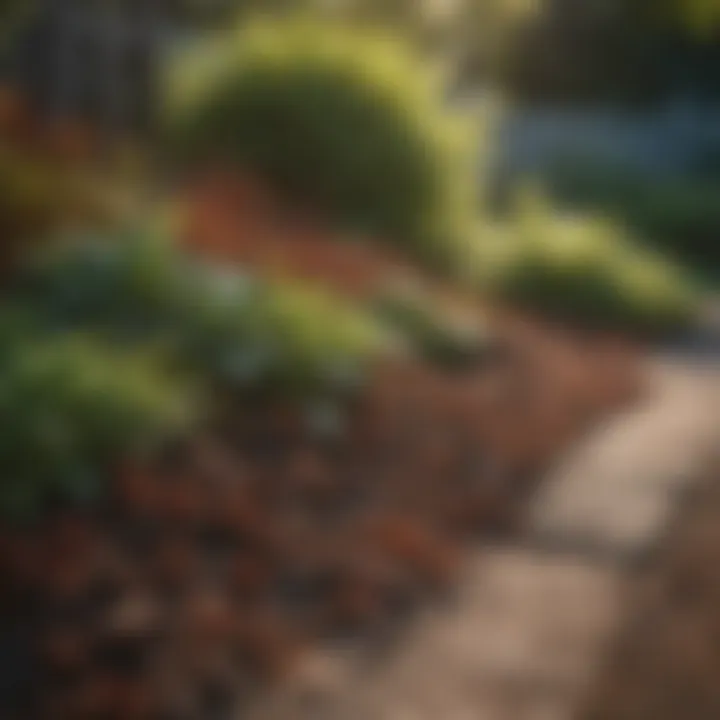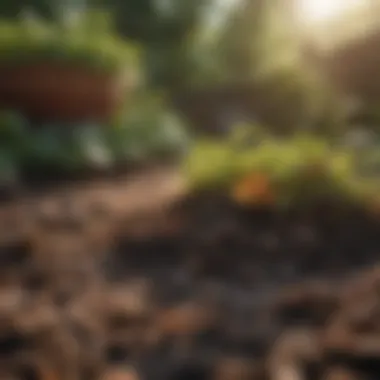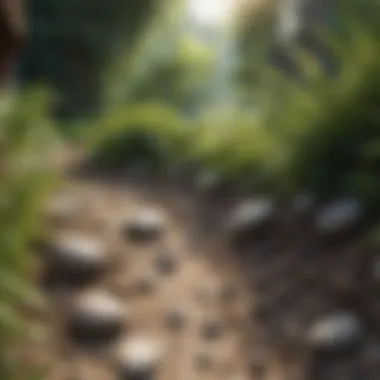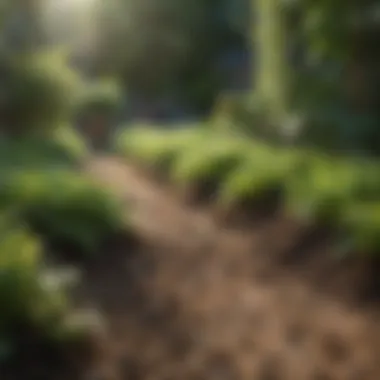Innovative Mulching Alternatives for Sustainable Gardening


Intro
Design Inspirations
When rethinking garden aesthetics and functionality, several design inspirations arise from alternative mulching materials. These inspirations not only contribute to the visual appeal but also significantly impact the garden’s overall health.
Trending Styles
A versatile approach is adopted by many gardeners today. Options such as wood chips, straw, and grass clippings allow for a rustic look while providing benefits like weed suppression and temperature regulation. The trend of using native plants alongside these materials is also gaining popularity, as they require less water and maintenance.
Color Palettes
The color palette of your garden can take on new dimensions with alternative mulching solutions. For example, dark wood chips can create a striking contrast with vibrant flowering plants. Additionally, using colored stones or gravel not only offers a contemporary feel but also improves drainage and reflects heat, fostering better growth.
Maintenance and Upkeep
Any gardening practice demands consistent maintenance. Implementing alternative mulching methods also has its own set of requirements to ensure sustained effectiveness.
Seasonal Maintenance Checklist
- Inspect the mulch layer regularly to determine if it requires replenishment.
- Check for weed growth; some alternatives may not suppress weeds as effectively as traditional mulch.
- Monitor moisture levels in the soil to ascertain whether the chosen material maintains adequate hydration.
- Evaluate plant health to ensure that any alternative solutions applied are successful in promoting growth.
Cleaning and Organization Tips
Maintaining cleanliness in the garden contributes to its overall health. Here are some practical tips:
- Establish clear pathways using stones or gravel to keep the garden organized.
- Regularly remove debris or fallen leaves that may hinder plant health.
- Keep storage of alternative mulching materials in a dry and sheltered space to maintain their effectiveness.
"Every alternative approach has its distinct advantages and potential drawbacks, making informed choices essential to gardening success."
Understanding Mulch
Mulch plays an essential role in gardening, functioning as a protective layer over soil. Its significance stretches beyond aesthetics; it aids in moisture retention, temperature regulation, and weed suppression. Understanding mulch is crucial for garden health, as it impacts the overall ecosystem beneath the surface.
Definition and Purpose
Mulch is any material applied to the surface of soil. This can include organic materials like wood chips, straw, or leaves, and inorganic materials like stones or plastic. The primary purpose of mulch is to conserve soil moisture, reduce temperature fluctuations, and prevent weeds from invading garden spaces. These benefits contribute significantly to healthier plants and more productive gardens.
- Moisture retention: Mulch reduces evaporation, maintaining soil moisture, essential during dry spells.
- Temperature regulation: It helps keep the soil temperature stable, promoting root growth.
- Weed suppression: A thick layer of mulch blocks sunlight, hindering weed seed germination.
In addition, mulch can improve soil structure over time. Organic types decompose and enrich the soil with nutrients, promoting microbial activity vital for plant health.
Common Types of Mulch
There are various types of mulch, each with specific characteristics and benefits:
- Organic Mulch: This includes materials like shredded bark, straw, grass clippings, and leaves. Organic mulches enrich the soil as they break down.
- Inorganic Mulch: Examples include gravel, rubber mulch, and landscaping fabric. These options do not decompose.
- Living Mulch: This refers to plants that are used to shade the soil and provide similar benefits as traditional mulch.
- Provides nutrients to plants.
- Attracts beneficial organisms such as earthworms.
- Generally more durable and require less maintenance.
- Often used in decorative landscaping.
- Can improve soil health and reduce erosion.
- Examples include clover or certain ground covers.
In summary, understanding mulch, its definition, purposes, and common types can lead gardeners to make informed decisions about soil management. In the following sections, various alternatives to traditional mulching will be explored, enhancing the potential for sustainable gardening practices.
Limitations of Traditional Mulch
Mulching is a common practice in gardening. However, it is essential to recognize the limitations of traditional mulch. Understanding these drawbacks can lead gardeners to better alternatives. Traditional mulch serves to manage weeds, retain moisture, and improve soil health, but it is not without its issues.
Environmental Impact
Traditional mulch often comes from non-renewable resources. For instance, rubber mulch, while popular, can take ages to decompose. Its production can generate a significant carbon footprint. Additionally, when organic mulches like wood chips decompose, they can emit greenhouse gases. This process contributes to climate change in some contexts. The transport of mulching materials can also exacerbate these impacts.


Moreover, some mulching materials may introduce contaminants in the soil. For example, dyed mulches can leach chemicals into the ground, affecting plant health. Therefore, the environmental concerns raise questions about sustainability in traditional mulching practices.
Efficacy Over Time
Another problem is that traditional mulch tends to lose its effectiveness over time. Organic materials like straw or leaves break down, requiring replacement every season. This can result in increased labor and costs for the gardener. As mulch decomposes, its ability to suppress weeds diminishes. Initially effective, it can turn into a breeding ground for pests if not maintained properly.
In contrast, inorganic alternatives, such as landscape fabric or gravel, might hold their efficacy longer but may also have their own downsides. Each type of mulch must be evaluated for its long-term benefits versus the potential drawbacks.
"Considering the limitations of traditional mulch not only informs better gardening choices but supports a move toward more sustainable practices."
By understanding the limitations of traditional mulching methods, gardeners can more effectively select alternatives that meet their gardening goals. This exploration will pave the way for innovative and sustainable solutions.
Exploring Organic Alternatives
In the quest for effective gardening practices, organic alternatives to traditional mulching offer numerous benefits. These options not only serve the primary purpose of protecting soil and plants but also contribute to a sustainable approach to gardening. Organic solutions are often more ecologically sound than traditional materials, making them a preferable choice for environmentally conscious gardeners.
One central advantage of organic alternatives is the enhancement of soil structure and fertility. As these materials decompose, they feed the soil microbiome, enriching it with nutrients. This results in healthier plants and an improved capacity for water retention. Additionally, organic mulches often support biodiversity by inviting beneficial organisms, which play crucial roles in pest control and pollination. Homeowners and gardening enthusiasts can find peace of mind knowing that these methods reduce their environmental footprint while promoting a balanced ecosystem.
Wood Chips and Shavings
Wood chips and shavings are commonly used in garden beds and pathways. They provide effective weed suppression and help in moisture retention in the soil. As they break down, they gradually release useful nutrients that benefit plants. However, there are a few considerations to keep in mind.
- Source of wood: It is important to choose cypress or cedar, as they resist decay better. Avoid treated wood, as it may contain harmful chemicals.
- Layering thickness: Use a layer of 2-4 inches for optimal results. Thinner layers may not be as effective for weed control, while thicker layers could restrict water evaporation.
Straw
Straw is another excellent organic mulching alternative. Mostly sourced from wheat, oats, or barley, it provides notable benefits. It can suppress weeds efficiently and help maintain soil moisture. Straw also adds organic material as it decomposes, improving soil quality over time.
- Advantages: Straw is lightweight, making it easy to spread. It decomposes relatively quickly and is often cost-effective.
- Limitations: Ensure to use clean straw, free from seeds, to prevent weed growth. Also, it may compress over time, requiring replenishing.
Grass Clippings
Using grass clippings not only benefits your garden but is also a great way to recycle waste from mowing activities. These clippings act as a nitrogen-rich mulch that can improve soil fertility as they break down.
- Application tips: Apply in thin layers to avoid matting, which can hinder water penetration and air circulation. An inch is usually sufficient.
- Considerations: Avoid clippings treated with herbicides or pesticides; this can negatively impact your plants.
Compost
Compost is often heralded as “black gold” for its numerous beneficial attributes. This rich organic material adds nutrients to the soil, improves structure, and enhances moisture retention. The application of compost as mulch could be one of the most beneficial practices for any gardener.
- Usage: Spread a layer of compost around plants to create a nutrient-rich environment.
- Additional benefits: Compost can help with weed control and attracts beneficial microorganisms.
In summary, exploring organic alternatives to mulch is advantageous for both your garden and the ecosystem. Each option has its strengths and some considerations, so gardeners should choose based on their unique needs and circumstances. Effective gardening practices rely on understanding materials and their implications, with organic solutions standing out as sustainable choices.
"The transition to organic gardening practices transforms not only landscapes but also lifestyles."
For more information on gardening techniques, check out resources on Wikipedia or engage with communities on Reddit.
Inorganic Alternatives
In gardening, inorganic alternatives to traditional mulch offer unique benefits and applications. They are crafted from non-biodegradable materials and often provide long-lasting solutions for weed control and moisture retention. Understanding the role of these materials is essential for gardeners looking to adopt sustainable practices while maintaining aesthetics and soil health.
Landscape Fabric
Landscape fabric is a popular choice among gardeners for its ability to control weeds effectively. It acts as a barrier between the soil and the surface, preventing sunlight from reaching weed seeds. This type of fabric is typically made from synthetic fibers, allowing water and nutrients to pass through while suppressing weed growth.
Benefits of Landscape Fabric:
- Durability: Landscape fabric can last many years if installed correctly, offering a long-term solution.
- Easy installation: It can be cut to fit any garden size, making it user-friendly for DIY projects.
- Soil health: Allows soil to breathe, supporting beneficial microorganisms.
However, there are some considerations when using landscape fabric:
- Cost: It can be more expensive than organic options.
- Over time: Some gardeners notice that the fabric can become clogged with soil and organic materials, reducing its effectiveness. Regular maintenance may be necessary to ensure its longevity.
Gravel and Rock


Gravel and rock as mulch materials are another inorganic alternative. These materials provide a visually appealing and practical solution for pathways and garden beds. They effectively suppress weeds and allow for good drainage, which is especially beneficial in wet climates.
Advantages of Using Gravel and Rock:
- Aesthetic appeal: They enhance the look of the garden with various colors and sizes.
- Weed control: Reduces weed growth due to lack of sunlight reaching the soil.
- No decomposition: Unlike organic mulches, gravel and rock do not break down, providing a permanent solution.
Nevertheless, there are drawbacks:
- Heat retention: Gravel can retain heat, which may not be ideal for all plants.
- Soil amendment: It does not add any nutrients to the soil, so additional fertilization might be required.
Rubber Mulch
Rubber mulch is made from recycled tires and has gained popularity for various gardening uses. Its unique properties make it suitable for landscaping, playgrounds, and garden beds.
Benefits of Rubber Mulch Includes:
- Durability: It does not decompose or fade over time, offering long-lasting protection.
- Shock absorption: Ideal for areas with foot traffic as it provides better cushioning compared to other mulches.
- Hydrophobic nature: It does not absorb water, which helps maintain soil moisture levels.
Contrarily, rubber mulch does come with some concerns:
- Chemical leaching: There is a potential risk of chemicals leaching into the soil, which could affect plant health.
- Cost: It tends to be pricier compared to traditional mulch options.
Overall, inorganic alternatives present diverse solutions for gardeners. They provide options that are practical and aesthetically pleasing, but careful consideration of benefits and drawbacks is necessary to select the best alternatives for specific gardening needs.
Innovative Biological Solutions
In modern gardening, the integration of innovative biological solutions serves as a pivotal strategy in enhancing garden health and sustainability. These methods leverage natural processes and organisms to enrich soil, suppress weeds, and maintain moisture. By embracing such alternatives, gardeners can foster an ecosystem that promotes biodiversity while reducing dependency on synthetic materials and practices.
Cover Crops
Cover crops are plants grown primarily to benefit the soil rather than for harvest. This strategy promotes soil health through various mechanisms:
- Soil Structure Improvement: The roots of cover crops help stabilize soil and prevent erosion. They create a network that holds soil particles together, enhancing its structure.
- Nutrient Cycling: Many cover crops, such as legumes, can fix nitrogen into the soil, providing essential nutrients for subsequent plantings. This natural fertilization reduces the need for chemical fertilizers.
- Weed Suppression: By covering the soil, these crops reduce sunlight exposure to weeds, thereby limiting their growth and competition for resources.
- Moisture Retention: During dry periods, cover crops can help retain moisture in the soil, benefiting main crops when they are planted.
Creating a cycle of planting and incorporating cover crops into your gardening routine can lead to long-term health and productivity. Properties of specific cover crops, like winter rye or clover, can fit various climates and plant needs. Incorporation timing is critical; most cover crops should be cut or tilled into the soil before they seed.
Garden Fabric Solutions
Garden fabric solutions, commonly known as landscape fabric, provide a synthetic alternative that still embodies biological principles. This material acts as a barrier against weeds while allowing water and nutrients to penetrate the soil. Here are some considerations:
- Weed Control: Garden fabric inhibits the growth of weeds, giving desired plants a competitive edge. This can reduce the need for herbicides.
- Soil Health Efficiency: While it does not enrich the soil directly, maintaining soil temperature and preventing soil compaction can foster a healthier growing environment.
- Durability: Unlike organic mulches, garden fabrics are long-lasting and can withstand various weather conditions. This could mean less frequent replacement and maintenance for the gardener.
However, it is essential to choose high-quality materials. Inadequate fabrics can degrade, allowing weeds to flourish. Over time, garden fabrics might require replacement or removal, so gardeners must plan accordingly to tackle potential downsides.
In summary, innovative biological solutions, such as cover crops and garden fabric solutions, provide effective means of enhancing soil health and maintaining garden productivity. By assessing benefits and potential drawbacks, gardeners can strategically implement these methods in their gardening practices, promoting a more sustainable approach.
Choosing the Right Alternative
Selecting an appropriate alternative to traditional mulching is crucial for effective gardening. It entails understanding various factors such as soil health, plant needs, and environmental conditions. A thoughtful choice can enhance soil fertility, conserve moisture, and suppress weeds while promoting the overall health of the garden ecosystem. The right alternative balances multiple variables, including cost, availability, and sustainability.
Assessing Soil Health
Assessing soil health is vital when choosing a mulching substitute. Healthy soil has a balanced composition of nutrients and organisms that support plant growth. Evaluating the soil involves several steps:
- Testing Soil Composition: Conduct a soil test to determine pH levels and nutrient availability. This information will guide you in selecting a mulch that complements existing soil properties.
- Identifying Soil Structure: Healthy soil typically has a crumbly texture and good drainage. Observe whether your soil retains moisture effectively or tends to be too compacted, which could influence mulching decisions.
- Understanding Microbial Activity: Healthy soil hosts various microorganisms. Their presence signals a thriving ecosystem, which is essential for plant growth. Consider mulches that promote this microscopic life, such as organic options that decompose and enrich the soil.
By focusing on these aspects, you can better understand which alternative will support the overall health of your garden.
Understanding Plant Needs
Understanding the specific needs of the plants in your garden is equally important. Each plant has unique requirements for light, water, and nutrients. Consider the following factors:
- Water Requirements: Different plants have varying needs for moisture. Some prefer drier conditions, while others thrive in moist environments. Choose a mulching alternative that helps maintain suitable moisture levels without waterlogging or drying out the roots.
- Nutrient Needs: Analyze what nutrients your plants require. Certain mulch types can add organic matter and nutrients over time, benefiting plants such as tomatoes or peppers that require rich soil.
- Growth Habits: Assess the growth patterns of your plants. Taller plants may need more light and less dense coverage than ground cover species, which might benefit from denser mulches that keep weeds at bay.
Fulfilling both soil and plant requirements leads to a well-functioning garden. The right alternative to traditional mulch will not only meet immediate needs but also promote long-term sustainability.


"Choosing the right alternative to mulch can significantly impact both soil health and plant growth, ensuring a thriving garden with lower maintenance needs."
Sustainability Considerations
Sustainability is a pivotal aspect in the realm of gardening. As the world becomes increasingly aware of environmental issues, the call for eco-friendly alternatives to traditional practices gains urgency. When it comes to mulching, the choices made can significantly influence the ecological footprint of a garden. Thus, understanding sustainability considerations helps gardeners choose options that not only serve short-term purposes but also sustain long-term health of ecosystems.
Resource Availability
Resource availability is foremost in evaluating sustainable gardening practices. It is essential to consider how and where the materials are sourced. For instance, locally sourced organic materials often have a smaller carbon footprint compared to imported products. This promotes community sustainability and encourages local economies. Here are several points to ponder in this regard:
- Opting for materials that can be easily gathered within one’s environment reduces the need for transportation. This translates to less fuel consumption and lower emissions.
- Reused or recycled items, such as newspaper, cardboard, or even kitchen scraps, can effectively serve as alternatives to commercial mulch, promoting waste reduction.
- Assessing the sustainability of a product also involves looking into its lifespan. For example, rubber mulch or landscape fabric has a longer durability than organic materials, but they may not decompose and contribute nutrients to the soil in the same way.
Making informed choices regarding resource availability fosters a more sustainable practice and yet meets the gardener’s specific needs.
Long-Term Ecological Impact
The long-term ecological impact of the chosen mulching alternatives cannot be underestimated. This consideration goes beyond initial benefits such as moisture retention and weed control. It encompasses how these alternatives affect soil health, local ecosystems, and biodiversity over time. Important facets include:
- Utilizing organic materials like straw or wood chips can enhance soil structure and fertility as they break down, contributing essential nutrients to the soil.
- In contrast, inorganic materials may provide immediate benefits but can lead to soil degradation and reduced microbial activity in the long run. This can ultimately hinder plant growth and soil vitality.
- Certain materials, like plastic landscape fabrics, may impede water infiltration and lead to the accumulation of harmful substances in the soil over extended periods.
"Choosing the right mulch alternative requires understanding its broader impact. The goal is to create a thriving garden without compromising the health of our planet."
In summary, sustainability in gardening requires a systematic evaluation of both resource availability and long-term ecological impact. Careful consideration of these factors leads to gardening practices that are beneficial not only to the plants but also to the environment. Engaging in sustainable methods ultimately cultivates a harmonious relationship between gardeners and nature.
Practical Applications of Alternatives
The practical applications of alternatives to mulching provide valuable insight for all gardening enthusiasts. Understanding how and when to implement these alternatives enhances overall garden health while minimizing the limitations associated with traditional mulch. Alternatives can contribute to soil improvement, weed control, and moisture retention. However, the effectiveness often depends on the specific gardening context, including soil type, weather conditions, and plant requirements.
By delving into practical applications, gardeners can make more informed choices that align with their goals. Utilizing alternatives effectively can lead to sustainable gardening practices that are beneficial both in the short and long term. It is crucial to approach this topic with an open mind, as different environments may yield varying results. Considerations like climate, pest control, and biodiversity also come into play when evaluating the potential of these alternatives.
"The best garden designs integrate practical solutions that marry both aesthetics and functionality."
Case Studies
Analyzing specific case studies can illuminate how various alternatives to mulch have been successfully applied in different gardening scenarios. For example, in a community garden in Portland, garden coordinators decided to replace wood mulch with a combination of compost and cover crops. This shift resulted in noticeable enhancements in soil fertility while keeping weeds manageable. The ongoing use of cover crops not only nourished the soil during off-seasons but also improved soil structure over time.
Similarly, in a residential garden setting, a homeowner chose gravel as an alternative to mulch in a xeriscape design. The gravel provided excellent drainage, minimized weed growth, and suited the drought-resistant plant selection. Observing the longevity and effectiveness of these materials presented an opportunity to understand the benefits and limitations of alternatives especially in arid environments.
Ultimately, case studies highlight the adaptability of alternative solutions to mulching, offering practical results that can inspire other gardeners.
Gardening Techniques
Employing specific gardening techniques alongside alternative solutions can further amplify their benefits. One effective technique is layering, which involves arranging different organic materials to build soil health. For instance, starting with a base of cardboard, adding a layer of compost, and topping with straw can create an effective barrier against weeds while enriching the soil underneath. This technique enhances nutrient retention, leading to improved plant growth over time.
Another technique is intercropping, which involves planting a combination of complementary crops in the same area. This practice can reduce dependency on mulch by creating a living cover that suppresses weeds and retains moisture.
Using drip irrigation alongside alternatives also proves beneficial. This method directs water straight to the roots, reducing evaporation. Combined with ground coverings like rubber mulch, these techniques minimize water loss. Integrating these gardening strategies with alternative solutions enables gardeners to address both immediate needs and long-term goals effectively.
Hopefully, embracing these practical applications will elevate gardening practices across diverse climates and soil types, reaffirming the viability of alternatives to traditional mulching.
The End and Future Perspectives
In the exploration of alternatives to traditional mulching, we uncover a landscape of innovative solutions tailored to meet the diverse needs of today’s gardeners. The significance of this topic cannot be overstated. As gardening practices evolve, so too must our approaches to soil health and management. The alternatives discussed not only enhance the growing environment but also contribute to broader sustainability goals. Understanding these options encourages homeowners and gardening enthusiasts to adopt practices that minimize environmental impact while maximizing plant health and productivity.
The thoughtful integration of alternative solutions reflects a proactive mindset in addressing the challenges posed by conventional mulching. Techniques such as using cover crops or landscape fabric enable gardeners to effectively manage weeds and soil erosion without the downsides associated with traditional materials. Furthermore, the exploration of sustainable practices leads to a more conscious engagement with our environment, promoting ecological balance.
Final Thoughts
As we conclude our discussion, it is clear that alternatives to traditional mulching present an exciting opportunity for innovation in gardening. Embracing these methods allows for greater flexibility and creativity in garden design. Gardeners can tailor their practices according to specific needs, soil conditions, and environmental considerations. This adaptability ensures that each gardening experience is unique and responsive to the challenges encountered.
It is essential, however, for gardeners to remain informed about their chosen methods. Regular assessment of their effectiveness concerning moisture retention, weed suppression, and soil health will ensure continued success. Engaging with peer-reviewed articles, expert opinions, and community forums can enhance understanding and inform best practices.
Emerging Trends in Gardening
The gardening landscape is ever-changing, revealing new trends that align with the principles of sustainability and ecological responsibility. One noteworthy trend is the increasing adoption of regenerative gardening practices, which focus on restoring soil health and improving biodiversity. This involves using organic alternatives such as compost and cover crops, which enrich the soil while minimizing the need for chemical inputs.
In addition, technology has begun to play a significant role in gardening. Innovations such as soil moisture sensors and automated irrigation systems are making it easier for gardeners to monitor conditions and apply alternatives to mulch effectively.
Moreover, urban gardening is gaining momentum. In urban environments, space is limited, and traditional mulching may not always be practical. Therefore, materials like gravel and landscape fabric are preferred due to their low maintenance and efficiency in weed control.
In summary, the future of gardening appears bright, with a promise of sustainable practices taking precedence. These emerging trends not only inform the practices of individual gardeners but also reflect a broader shift towards responsible stewardship of our shared environment.







